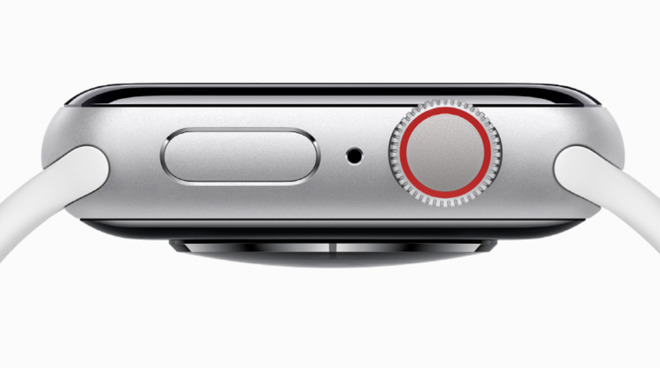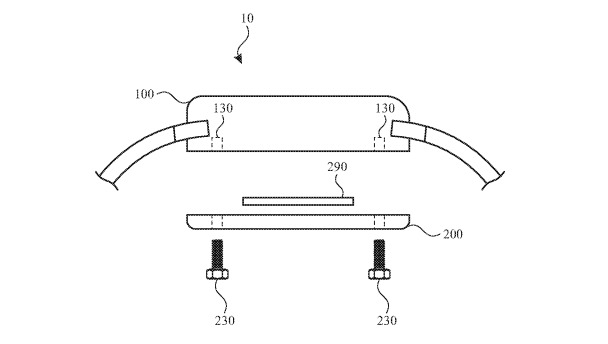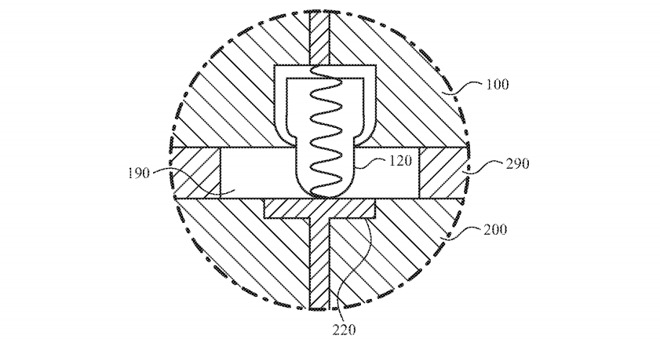Apple Watch of the future could have a modular back for upgrades & new sensors
Future versions of the Apple Watch could be upgradable, with the addition of a modular section to the back that adds new sensors and functionality to the wearable device, or to enhance the existing functions like battery life.

The Apple Watch is one of the most popular wearable devices available, in part due to its sleek and compact design and its functionality. However, the small device is built in a way that makes it hard to add new features or functions to it, leaving users to upgrade the entire device if they want new elements.
The lack of upgradability also means users are limited only to the capabilities of the device itself. For example, short of using a portable power bank and bringing the charging puck with them, a user cannot go off-grid for a week and expect the Apple Watch to last the entire time equipped with just the currently available amount of battery life.
In a patent application titled "Modular System for Watch" and published by the US Patent and Trademark Office on Thursday, Apple proposes it may be possible to add new elements to an Apple Watch-like device, by building in the option to upgrade via the rear.

An example of using bolts to hold an Apple Watch module to the back of the device
Rather than allowing users to open up the Apple Watch, Apple suggests the use of a variety of modules that can be attached to the back of the device. This effectively helps eliminate any possibility of the Apple Watch itself losing any of its existing water resistance capabilities.
The module is able to mount onto the back of the Apple Watch, attached by a variety of different mechanisms. Rails and bolt systems are suggested as ways to do so, among others, though the filing also includes claims where the modules could be easily connected or removed from the main Watch body without necessarily requiring tools to do so, via the use of retaining and release mechanisms.
By placing the module on the rear, it is also able to be held in place by tension from the Watch pulled by the band against the user's wrist, helping further secure the add-on. There is also mention of a possible "water-tight seal," which could help maintain the integrity of elements between the module and the Watch.

An example of a pogo pin that could be used to establish a connection between Apple Watch and module
To enable held components offer extra functionality to the Apple Watch itself, there have to be connections where the module can openly communicate or transfer power with the main body. This could be via the use of a pogo pin, a spring-loaded pin that can provide pressure against a plate to establish a physical connection.
The application lists its inventors as Maegan K. Spencer, Sherry Tang, and Morgan T. McClure.
Apple files numerous patent applications on a weekly basis, but while the existence of a patent indicates areas of interest for Apple's research and development efforts, there is no guarantee that the concepts will appear in a future product or service.
Modular Apple Watch modules have been explored in the past, but have so far failed to make it to market in any meaningful form. The closest patent to the latest filing would be the "Auxiliary electronic device attachable to a wearable electronic device," granted to Apple in April 2018, which suggests how a plate could snap into the existing Watch Band slots to attach to the watch.
Other ideas have included upgraded bands containing sensors and batteries, a band that hides electronics in bracelet links to keep the mass of the Apple Watch itself down, and even using watch bands as wireless antennas.

The Apple Watch is one of the most popular wearable devices available, in part due to its sleek and compact design and its functionality. However, the small device is built in a way that makes it hard to add new features or functions to it, leaving users to upgrade the entire device if they want new elements.
The lack of upgradability also means users are limited only to the capabilities of the device itself. For example, short of using a portable power bank and bringing the charging puck with them, a user cannot go off-grid for a week and expect the Apple Watch to last the entire time equipped with just the currently available amount of battery life.
In a patent application titled "Modular System for Watch" and published by the US Patent and Trademark Office on Thursday, Apple proposes it may be possible to add new elements to an Apple Watch-like device, by building in the option to upgrade via the rear.

An example of using bolts to hold an Apple Watch module to the back of the device
Rather than allowing users to open up the Apple Watch, Apple suggests the use of a variety of modules that can be attached to the back of the device. This effectively helps eliminate any possibility of the Apple Watch itself losing any of its existing water resistance capabilities.
The module is able to mount onto the back of the Apple Watch, attached by a variety of different mechanisms. Rails and bolt systems are suggested as ways to do so, among others, though the filing also includes claims where the modules could be easily connected or removed from the main Watch body without necessarily requiring tools to do so, via the use of retaining and release mechanisms.
By placing the module on the rear, it is also able to be held in place by tension from the Watch pulled by the band against the user's wrist, helping further secure the add-on. There is also mention of a possible "water-tight seal," which could help maintain the integrity of elements between the module and the Watch.

An example of a pogo pin that could be used to establish a connection between Apple Watch and module
To enable held components offer extra functionality to the Apple Watch itself, there have to be connections where the module can openly communicate or transfer power with the main body. This could be via the use of a pogo pin, a spring-loaded pin that can provide pressure against a plate to establish a physical connection.
The application lists its inventors as Maegan K. Spencer, Sherry Tang, and Morgan T. McClure.
Apple files numerous patent applications on a weekly basis, but while the existence of a patent indicates areas of interest for Apple's research and development efforts, there is no guarantee that the concepts will appear in a future product or service.
Modular Apple Watch modules have been explored in the past, but have so far failed to make it to market in any meaningful form. The closest patent to the latest filing would be the "Auxiliary electronic device attachable to a wearable electronic device," granted to Apple in April 2018, which suggests how a plate could snap into the existing Watch Band slots to attach to the watch.
Other ideas have included upgraded bands containing sensors and batteries, a band that hides electronics in bracelet links to keep the mass of the Apple Watch itself down, and even using watch bands as wireless antennas.

Comments
People that can afford the Edition don't care. They buy $250 shirts and use them a few days.
The bigger 'issue' is that we're still on the steeper part of the curve for the Apple Watch and the capabilities continue to increase so they become outdated before the battery wears out (and end up being more technological waste.) This isn't as dramatic as it was with iPhones when they first came out but still plays into it and I do think the batteries should be replaceable, but to say the watch is dead after 3 years is hyperbole.
Extensibility would be endless.
Agreed. Flying a private jet costs more than than flying even first class, but the people I know who do it don't care.
https://www.ifixit.com/Guide/Apple+Watch+Battery+Replacement/41080
As for APs, that doesn't bother me that they replace them, since Apple is great at recycling materials and surely isn't tossing the consumed batteries in the ground. It's more processed and recycled that the typical kids toy, so when I get the APP I'll gladly pay $30 for the AppleCare and get the battery service before its term ends.
Having said that, my daughter has my old 0, and I see your point on the battery exchangeability.
So true!
I think the earlier days of the iPhone may be the analogy: until fairly recently the expected life of an iPhone was about 2 years. That was of course partly because of 2 year contracts with the carriers and partly because the state of the art had moved so far that a 2 year old phone was ancient. Today, phones run 4-5 years and battery replacements have become routine.
The AppleWatch will eventually reach that maturity where updates are less revolutionary and more evolutionary. But that day is not this day.
But, regardless, due to its extreme emphasis on size, weight and water resistance, a user replaceable battery (unless it is moved to the band) is highly unlikely
And the original poster is an example of that. He mentions having bought a Series 0 which is "outdated" by todays standards but he still bought it. People In third-world countries would think he's crazy.